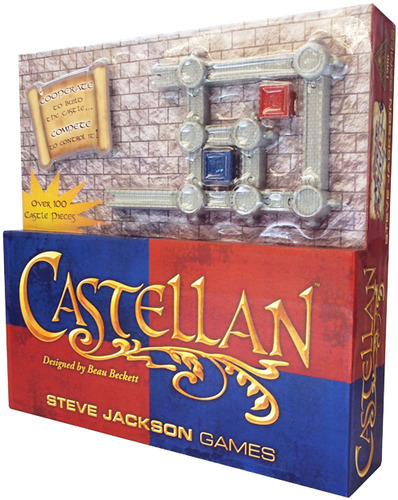
The Basics:
- For ages 4 and up (publisher suggests 10+)
- For 2 players (4 if playing in teams)
- About 30 minutes to complete
Geek Skills:
- Counting & Math
- Logical & Critical Decision Making
- Pattern/Color Matching
- Strategy & Tactics
- Hand/Resource Management
- Area Control
- Cooperative & Team Play
Learning Curve:
- Child – Easy
- Adult – Easy
Theme & Narrative:
- Castellans of the realm compete for dominance as they race to build the biggest and best castle for their Lord!
Endorsements:
- Gamer Geek approved!
- Parent Geek approved!
- Child Geek approved!
Overview
A king and kingdom is nothing without a castle. From the high walls, lords and ladies look out upon the land they rule and at the people they protect. But for some lordlings, the walls that surround their holdings is not enough. The truly ambitious seek to expand their territory and control. Their walls of power and of stone begin to stretch and travel outward, encompassing more and more land. It falls to you, the Lord’s castellan, to build such a castle. A challenge made all the more difficult by your rivals competing for your lord’s favor.
Castellan, designed by Beau Beckett and published by Steve Jackon Games, is a 2-player game (4 players if you play in teams) of area control and puzzle solving. The game is comprised of 26 Long Walls, 30 Short Walls, 32 Towers, 20 Keeps (10 Keeps to each player in two different colors), and 28 cards (14 cards to each player in two different colors). The Walls, Towers, and Keeps are made of solid plastic and are detailed to look like real stone. The Walls and Towers easily fit together with the Towers extending four spokes at 90 degree angles that the Walls can connect to with a single slot on each end. The plastic pieces, as well as the cards, are of excellent quality, insuring the game is playable and enjoyed for many game sessions to come.
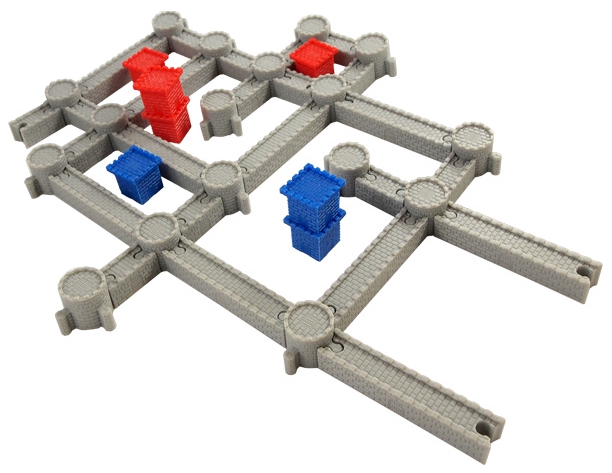
The pieces of the game are all wonderfully detailed, very durable, and fit easily together
Game Set Up
Before setting up the game, ensure that your playing area is at least 16 inches by 16 inches of clear space. This area is needed to contain the castles as the Walls extend further and further outward.
Once the playing area is cleared, each player selects a color and takes all the Keeps and cards that match. The players should separate their cards into a Tower and a Wall decks (easily identified by the back of the cards), shuffling them, and placing the decks face-down immediately in front of them. The players should also place their pile of Keeps within easy reach. Place the Wall and Tower pieces to the side of the playing area and within easy reach of both players.
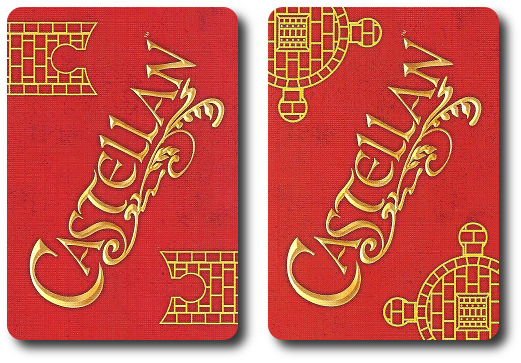
Wall card on the left and Tower card on the right
Lastly, each player draws 2 Tower and 2 Wall cards for their starting hand, for a total of four cards.
You are now ready to play the game!
Cards and Castles
The cards in the game are separated into two specific types. These are Walls and Towers. On the card’s face will be images of Wall and Tower pieces. These images indicated what type and number of pieces will be collected and played on the player’s turn. For example, a card that shows a Tower and two Long Walls means the player selects 1 Tower and 2 Long Walls to build with on their turn.
Note: Players have the same number and the same type of cards. Each deck is a complete copy of the other with the only difference between them being the color of the card’s back. There will ALWAYS be enough pieces for each player to claim with their cards, too.
The Wall deck will always favor Wall pieces and the Tower deck will always favor the Tower pieces, but not exclusively. On some of the Wall cards a Tower will be displayed and on some of the Tower cards, a Wall or two will be shown. When selecting a card, the player should select one or the other based on what they need to build first and use whatever else comes with the card as a secondary step towards victory.
Included on some of the cards is an image of a card. This means the player will draw a bonus card during their turn. For quick reference, each of the cards has small icons in the upper left and lower right of the card’s face. This makes it easy for the player to quickly review what they have available to them in their hand by fanning out the cards.
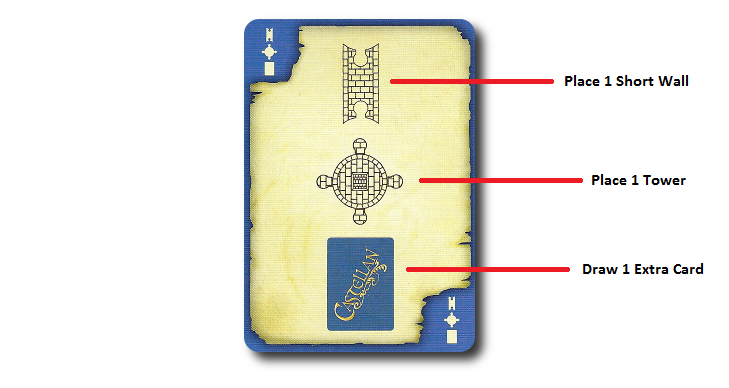
Building Walls
The rules for building castles if very straight forward. Walls must connect to at least one Tower and Towers must connect to at least one Wall. This also means that there must always be space for a Wall to have a Tower attached on either of its two ends and every Tower must have enough room to add a Wall to any of its four spokes. Players can never have any Walls or Towers not connected to any other piece. I should also note that the interlocking Towers and Walls make the game very easy to slide around. If the castle is getting a bit too close to the edge, simply grab a piece and slide the entire castle towards the center of the table. We had to do this many times and not once did the castle come apart.
If both parties agree, players can place their Walls and Towers to the side before physically attaching them. Otherwise, a “piece laid is a piece played”. Additionally, a player cannot build within a courtyard (any areas surrounded by four or more Walls) that has already been claimed by their opponent’s Keep. That would, after all, be trespassing.
On Rule and Measure
Castellan is played in turns with no set number of turns per game. A player’s turn is divided into 5 sequential steps which are summarized here.
Step 1: Play Cards
Playing one card at a time from their hand, the player places a card face-up in their discard pile. The player then collects all the pieces shown on that card. A player can play as many cards in their hand as they like during this step, but must play at least 1 card per turn. Using the pieces they collected from the card or cards they played, they now build to the castle.
Step 2: Build
The player must use all the pieces they have collected and build onto existing Walls and Towers using the build rules noted above. If the player is going first, they must use at least one Wall and one Tower piece to start the castle. If any piece is collected and cannot be placed correctly, it’s passed to the opponent to be built on their turn. Passed pieces are used in addition to any other pieces the opponent collects using their cards.
Step 3: Claiming Courtyards
Any completely enclosed space is considered a “courtyard”. A player places one of their Keeps in the courtyard signifying it belongs to them, if they choose. If the player separates one of their own courtyards by using a Wall, they can claim the new courtyard by simply placing one of their Keeps in the newly separated area. Remember, players cannot play pieces to courtyards claimed by their opponents, no matter how big that courtyard might be.
The first time a player claims a courtyard, they have the option of placing two Keeps, stacking one on top of the other. This will count as double points at the end of the game, but cannot be later broken apart during the game.
Like the Tower and Wall pieces, Keep pieces cannot be moved once played.
Step 4: Draw Cards
Regardless of the number of cards played, the player is only allowed to draw one card from the deck of their choice, by default. If the player played cards during step 1 with a card icon, they draw an extra card for every card icon shown. There is no hand size limit.
Players cannot look at their cards until they have finished drawing them all.
Step 5: Discard and Trash
All cards played during the players turn are now discarded and removed for the duration of the game. It’s now the other player’s turn, starting with step 1 noted above.
A King’s Victory
Once one of the players ends their turn with no more cards left to draw or to play, the other player draws any remaining cards they might have and completes the turn steps. Any unplayed pieces are simply set aside.
Points are now counted to determine the winner of the game. A player earns points for the number of Towers that make up the courtyard that surrounds their Keeps. For example, a Keep surrounded by 7 Towers will score 7 points. A courtyard with a double Keep is worth double the points. For example, the same a 7 Tower courtyard with 2 Keeps will score 14 points. Towers can be scored by both players but only for each Keep once. It’s suggested that the players place the Keeps on their sides once they have counted the points earned for that Keep. I highly suggest you do so, too, as keeping track of Keeps and points can be difficult with larger castles.
The player with the most points wins the game and the kingdom!
Game Variants
Team Play
Castellan can be played in teams with 4-players. Game set up is as normal, except the team members can discuss their strategy and where they will be building. Team members cannot, however, show the cards they will be playing (unless otherwise changed by a House Rule). Team members can build in the other team member’s previously claimed courtyard if permission is given. The winning team is the one with the most combined points.
Expanding to a 3 to 4-Player Game
Castellan comes in two different editions with each edition having different Keep colors. By combining the two different editions, Castellan can be played with 3 to 4-players instead of 2. It’s important to note that Castellan is complete “as is” and does not require the other edition to play. In fact, both editions are the same except for the Keep and card colors they contain. Adding the other edition only increased the number of players, game pieces, and possibilities. It will also increase the game’s length to about an hour or a little more.
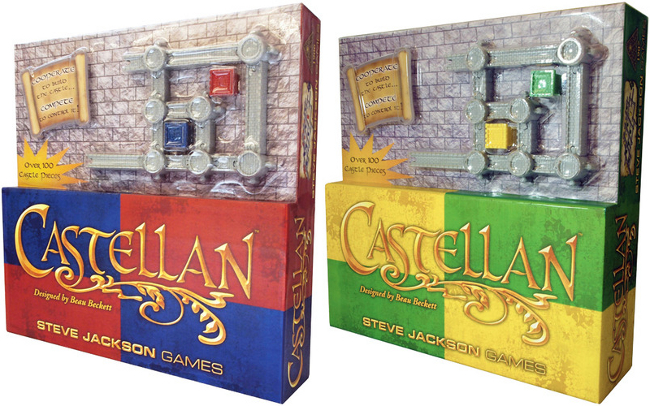
To learn more about Castellan, see the game’s official website.
Prediction
While I am sure this game will be met with excitement by all my little geeks, I think my 4-year-old will be the most pleased. He loves puzzle solving games and building things. He’s a wiz at LEGO and is always working on a puzzle, building a robot, or designing the next great board game out of LEGO pieces and other game bits. As of late, he has become more and more frustrated with me as Father Geek pushes the envelope with more complicated games. Games, I must add, that are slightly out of reach of my 4-year-old to play. In his words, “these games are too hard for me to play.” That might very well be true, but I also tell him that nothing that comes easy is worth as much as something you worked hard for. Of course, he doesn’t buy a word of it.
I was overjoyed when I was sent this game to review, immediately knowing that it would do wonders for my 4-year-old’s ego and revive his interest in games. I was getting tired of seeing him stomp away from the table whenever a new game was introduced. His automatic acceptance of defeat was not helpful or healthy. I would always bring him back to the table, only to have him decide that the game was “not for him” well before he even understood what it was about.
This had to change.
I sat my 4-year-old down, gave him a glass of milk, and told him we were going to build castles. I took out the game and dumped out the plastic Walls, Towers, and Keeps. When he asked me what the game was, I told him it wasn’t a game. We were just going to build castles. And so we did, for a good 1/2 hour. While we did so, the other brothers got involved and pretty soon everyone was building. When my 7-year-old got tired of it, my 4 and 2-year-old didn’t leave the table when they were asked to go play outside. They just kept focused and built like crazy. That’s all we did that day with Castellan and it was enough to make my 4-year-old come back for more.

All three little geeks are happily building their castles – little do they know they are learning a game, too!
On Day Two, I told my 4-year-old we were going to play a game with the castle pieces. We would both take turns selecting a piece and adding it to the castle. Whenever one of us created a courtyard, we would put a Keep in the middle. He was more than happy to play the game as we cooperatively built an epic castle. Again, he left the table feeling happy and satisfied.
On Day Three, I introduced the game in full, explaining the cards and that we were now going to build the same castles using the cards to determine what pieces we could use. When we created a courtyard, we claimed it as our own. When we couldn’t use a piece, it was given to the other player. The player with the most points, by counting the Towers around the Keeps, would win. He understood the game and what he had to do, immediately.
Oh, yes, it was on!
But before we started the game, I asked him his thoughts.
“I really like this game and I like how we can build castles together. But I’m going to win, Daddy!” ~ Nyhus (age 4)
Huzzah! My little 4-year-old geek has returned! Let’s see if Castellan is enough to bring him back to the Geek Side or it’s just one more game that disappoints him.
Final Word
Castellan was a complete success! Not only did my 4-year-old play it well, he loved it! He was once again excited about games and loves playing it, as well as just building with the pieces. He is able to express himself creatively when building rather large and complex castles and able to challenge himself when he plays the game. The end result is a game that makes him frown with concentration and smile with joy. Perfect.
But the good news doesn’t stop there. My 2-year-old asks for the game by name and plays with the castle blocks at the table. His castles are becoming bigger and bigger, and it’s clear he is understanding how they connect together. He is still a few years away from playing the game, but he is already showing real promise. My 7-year-old also loves the game, but he is more focused on the game itself rather than the building. He has become rather competitive as of late and he is willing to play games pretty much whenever. How happy am I?!
For the Parent and Gamer Geeks, Castellan was also well received. The only complaint I heard from the Parent Geeks is that it was a 2-player game. When I told them it could be made into a 4-player game, they were happy to hear it and then disappointed that they would have to buy another copy of the same game. Gamer Geeks didn’t mind that at all (being buyers of games in bulk already), and enjoyed the quick play and concentration needed to play the game competitively. Even the non-gamers had a good time, as building castle walls is something everyone can relate to and enjoy. There are very few of us who have never built anything with blocks, after all.
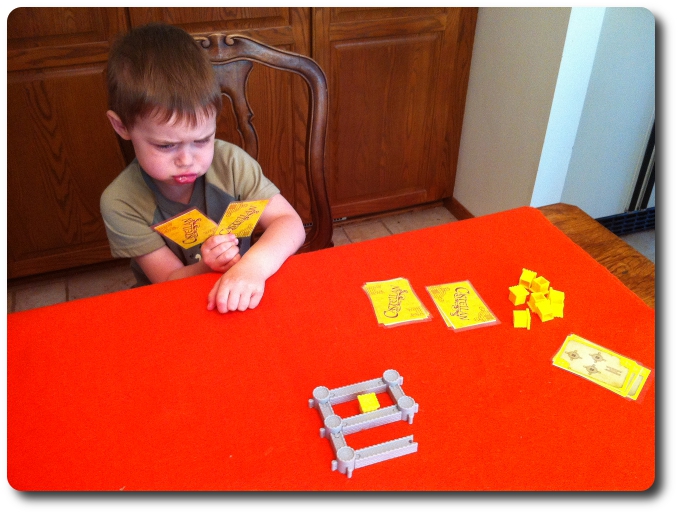
My 4-year-old frowns as he realizes he cannot close the courtyard – I did close it and he gave me an even sterner look
Gamer Geeks, Castellan is light, fast, and fun. The challenge comes in selecting the right pieces on your cards. You must out last and out manuever your opponent to win. This is no easy task. Each round you must play at least one card and play the pieces. It does you no good to just place a piece randomly as your opponent will quickly use it to their advantage. Every Keep placed is a point, but place them wisely. Place them too early, and you’ll miss out on points. Place them too late and you won’t get any points at all. Highly recommend the game as a quick starter game or when waiting for your geek crew to arrive.
Parent Geeks, this is a wonderful 2-player game of logic and area control. It’s fun to build and to see the castle grow ever larger and more interesting as the game continues. The game can be played quickly, but you’ll want to take your time. Thinking through each move is necessary and if you rush, you will make mistakes. Expect a lot of second guessing and eye rolling as you watch your opponent claim points on a Wall you just built and shout for victory when you close a courtyard and score big points! Don’t like how the game played? Not a problem? Simple break it down and play it again in minutes!
Child Geeks, this is a fun game for two reasons. First, it’s fun to build with. You can take the castle parts and build wonderfully complicated and fantastic castles. Have fun building whatever you can imagine, and when doing so, you’ll be making yourself a better player! As you build the Walls and Towers, your brain will be learning how the pieces go together, making the game all the easier and more fun for you when you play competitively. Second, the game is a lot of fun! With two people playing, the castle will stretch and twist, challenging you to determine where best to build and when to claim points. As long as you are having fun, you are doing it right!
Castellan is a fun game, but not unique. There are other games that use the same concept of surrounding areas and claiming them. What does set Castellan apart from the rest is the detail in the Walls, Towers, and Keeps, as well as the easy way everything fits together. Every bit and aspect of the game is seamless. I was never lost or confused when it came to the rules and every player at the table who had a chance to play it wanted to play it again. It’s visually appealing as well as mentally satisfying. This leaves the player happy, and more times than not, ready for more. If building castles is your thing and you like a good puzzle game where area control is the key to success, do give Castellan more than just a passing glance. You’ll be happy you did.
This game was given to Father Geek as a review copy. Father Geek was not paid, bribed, wined, dined, or threatened in vain hopes of influencing this review. Such is the statuesque and legendary integrity of Father Geek.



